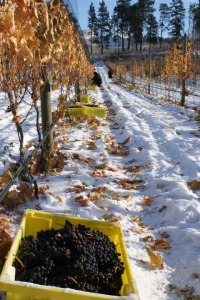 Icewine was in the news this week as the cold snap had wineries springing into action for the second earliest icewine harvest on record—the earliest being Nov 5th, 2003. Judging by comments from the Okanagan, this may well prove also to be one of the largest icewine harvests on record.
Icewine was in the news this week as the cold snap had wineries springing into action for the second earliest icewine harvest on record—the earliest being Nov 5th, 2003. Judging by comments from the Okanagan, this may well prove also to be one of the largest icewine harvests on record.
That begs the question, is it really worth it?
It all depends on who you talk to. From the grower’s point of view, icewine requires an immense amount of resources. And even before they get to harvest it there’s a strong possibility that other enthusiasts, from bears to birds, will try to get their share.
All of which means that, by the time it gets to your local shelf, it doesn’t come cheap.
The consensus is that a great vintage (which 2014 promises to be) will likely yield a superb icewine—even more so, say some, because of the early freeze. Although, interestingly, there’s also a camp who suggests that multiple ‘mini-freezes (before the required sustained harvest temperature of -8C) can make for a more complex and interesting final result.
Summerhill CEO Ezra Cipes is pumped:
(From the BCWI release:)
“Icewine is something we can do better here in the Okanagan than anywhere else on earth. To make outstanding icewine you need to start with outstanding grapes, and 2014 was one of the best Okanagan growing seasons ever. Now to have this cold snap so early in November, and harvest our icewine grapes before the birds get them is making us all smile and sing around the winery. This is a blessed vintage.”
Interestingly enough, one producer that won’t be making icewine—for the first time in 20 years—is Tinhorn Creek, which usually makes a (very good) Kerner icewine.
As luck would have it, this year their Kerner needed to be replanted.
“When we do that we try to figure if it’s time for a change. If we did a lot more Icewine it would go to Asia,” says Tinhorn CEO Sandra Oldfield, who notes:
“Canadians don’t really drink it.”
So, how come?
Even a 375 ml. (half) bottle is too much for most people to consume at one sitting. My hunch is that the most successful wineries at selling wines to Canadians are those like Nk’Mip, Paradise Ranch and Tinhorn, who have traditionally bottled smaller, 200 ml. sizes.
Secondly, true to Canadian form, we really don’t make that much fuss about it. Icewine presents a wonderful opportunity for pastry chefs to play and show off their skills. But you’ll rarely see a suggested icewine pairing on a dessert menu—unless it’s a tourist driven resto.
My hunch is that the style and weight of many icewines is just too sweet for most people’s palates. No argument, it can be impressive to savour a wine with upwards of often 200 grams per litre of residual sugar. But your tastebuds can only take so much.
Never fear! Here’s Hired Belly’s failsafe dessert to guarantee you can enjoy at least some of that bottle of liquid gold you may have tucked away.
A perfect icewine dessert
(The main rule of pairing ice wine is that the dessert should be lighter and less sweet tasting than the wine…)
• Blend three parts soft commercial goat cheese with two parts good quality French vanilla ice cream (such as from Whole Foods).
- When the creamy mix tastes just slightly more savoury than sweet, you’ve made the perfect match.
- Divide into portions and refreeze until a couple of hours before serving, then top with fruit slices such as apple, pear or kiwi.
You’ll be amazed how well it goes with ice wine, Riesling in particular…
Don’t serve it too cold—an hour or two in the fridge (around 10 C.) should be fine. And pour a small taste into a regular white wine glass to best appreciate the aromas.
• Mission Hill Reserve Riesling Icewine 2013. A perennial winner: bright forward notes of citrus and floral notes, with marmalade hints on a viscous palate, balanced by a streak of acidity with a lingering citrus and honey finish. 92 pts. BCLS $59.99 (375 ml.)
This column ran in this weekend’s North Shore News
Leave A Comment